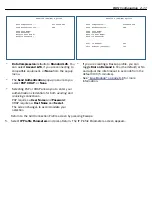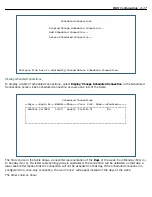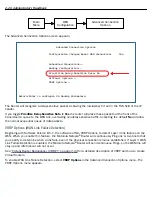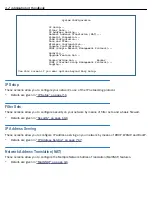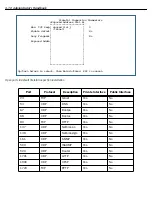
2-24 Administrator’s Handbook
bandwidths from 20 kbps to 90 kbps, depending on the CODEC setting – compared to the total throughput bandwidth of the
Gateway and the network. There will usually be fewer than two or three packets pending in the Gateway in any queue in the
Gateway during the conversation. If, during the call, however, a user is sur fing and decides to download, or upload, a file
through the Gateway, it is possible that during the file transfer the voice quality of the VoIP call could be degraded. A higher
setting for the lohi-asymmetr y will prevent this from occurring.
On the other hand, if 10 or 20 VoIP calls are simultaneously being handled by the Gateway, for example, in an office setting,
then 1000-2000 packets/sec are being throughput at high priority. If one or several of the callers in the office then attempt
to download, 10-15 packets may be pending in the low priority receive queues, with perhaps 2-3 pending in the high. The
corresponding asymmetr y in this case would be around 80-86%. If it were found in this situation that the file transfers were
too sluggish, then the lohi-asymmetr y threshold could be set to 80%. This would cause more of the low priority traffic to be
throughput, at the expense of the high priority streams. As a result, the file downloads might proceed at a more satisfactor y
rate, while the degradation to the 10 or 20 VoIP calls might not be noticeable.
The lo-hi asymmetr y parameter is therefore one means of balancing the traffic load to satisfy ever yone.
You can then define custom Rules. If your applications do not provide Quality of Ser vice (QoS) control, rules
allow you to define streams for some protocols, por t ranges, and between specific end point addresses.
•
To define a Rule, select
Add Rules
and press Return.
(Once you have added one or more rules, you can edit any of them by returning to this screen and selecting
Show/Change Rules
.)
The Diffser v Rule screen appears.
•
Name
– Enter a name in this field to label the rule.
•
Protocol
– Select the protocol from the pop-up menu: TCP (default), UDP, ICMP, or Other. “Other” is
appropriate for setting up rules on protocols with non-standard por t definitions. IPSEC and PPTP are
common examples.
Diffserv Rule
Name:
Protocol... TCP
Priority... off
Direction... outbound
Start Port: 0
End Port: 0
Inside Ip Address: 0.0.0.0
Inside Ip Netmask: 0.0.0.0
Outside Ip Address: 0.0.0.0
Outside Ip Netmask: 0.0.0.0
COMMIT CANCEL
Return accepts * ESC cancels * Left/Right moves insertion point * Del deletes.
Содержание Netopia Embedded Software
Страница 1: ...Administrator s Handbook Motorola Netopia Embedded Seftware Version 8 7 4 Enterprise Series Routers ...
Страница 10: ...x Administrator s Handbook ...
Страница 16: ...1 6 Administrator s Handbook ...
Страница 44: ...2 28 Administrator s Handbook ...
Страница 108: ...3 64 Administrator s Handbook ...
Страница 176: ...5 34 Administrator s Handbook ...
Страница 202: ...6 26 Administrator s Handbook ...
Страница 243: ...IP Setup 7 41 Additional LAN Configuration Name IP Address Additional LAN 1 1 1 1 1 Additional LAN 2 0 0 0 0 ...
Страница 244: ...7 42 Administrator s Handbook ...
Страница 340: ...Index 6 ...


